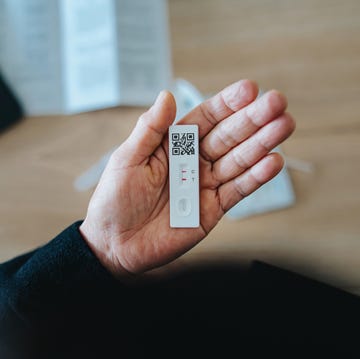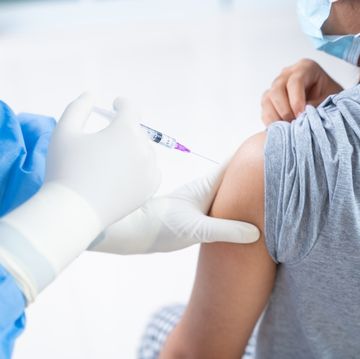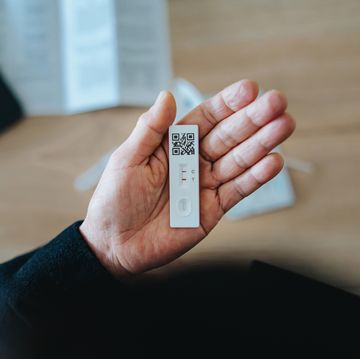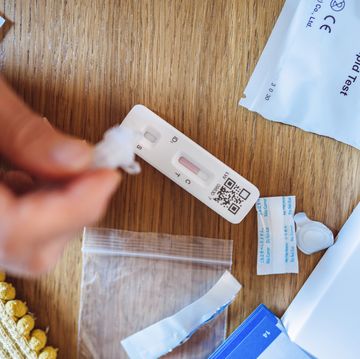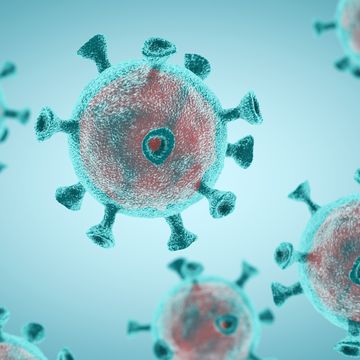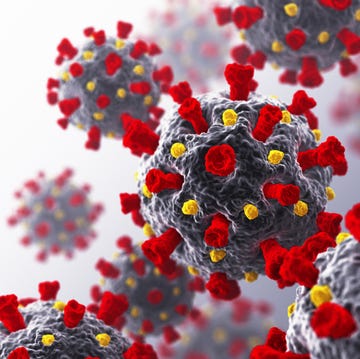When COVID-19 started spreading across the globe earlier this year, major health organizations—including the Centers for Disease Control and Prevention (CDC) and World Health Organization (WHO)—held firmly to one stance: The novel coronavirus is transmitted through infected respiratory droplets, primarily after a person coughs or sneezes.
But now, a group of 239 scientists from 32 different countries are urging the WHO to reconsider. Those scientists wrote an open letter obtained by The New York Times that says evidence shows smaller, aerosolized particles can contain SARS-CoV-2, the novel coronavirus that causes COVID-19. Those particles can infect people, the scientists argue, and they suggest the WHO should revise its recommendations as a result. The letter is expected to be published in the medical journal Clinical Infectious Diseases next week.
In its most recent update on the virus, the WHO says that it’s possible for the coronavirus to be transmitted through the air, but only after certain medical procedures like intubation are performed. That said, experts still have mixed opinions on whether or not the virus is truly airborne, and what that means for public health recommendations. Here’s what we know so far.
What does it mean for a virus to be airborne?
“When something is airborne, it means it can remain suspended in the air for a period of time—for hours—and that the air is infectious,” explains infectious disease expert Amesh A. Adalja, M.D., senior scholar at the Johns Hopkins Center for Health Security.
He cites measles and tuberculosis as airborne diseases, and explains that “if someone has measles and rides in an elevator, and you get on a half hour after they’ve left, that air is still infectious.”
When patients have a virus or disease that is airborne, it “changes how we treat those patients in a hospital,” Dr. Adalja says, noting that they’re often put into a negative pressure room and that medical staff needs to wear N95 masks—which filter out a majority of air particles that are breathed through it—to protect themselves.
How does airborne transmission compare to respiratory droplet transmission?
Respiratory droplets are different from aerosols, Dr. Adalja says: They’re heavier and quickly fall to the ground after they’re produced. The main concern with respiratory droplets produced from an infected person with COVID-19 is that those droplets can land in the mouths or noses of people who are nearby or can possibly be inhaled into the lungs, the CDC says.
In the case of COVID-19, from what is understood right now, people are more likely to be infected by respiratory droplets produced by someone with the virus when they’re in close contact, which is defined as less than a six-foot distance, the CDC says.
On the flip side, some experts suggest that we need to look at what “airborne” means a bit differently and that “the WHO is relying on a dated definition of airborne transmission,” per The New York Times, as “the agency believes an airborne pathogen, like the measles virus, has to be highly infectious and to travel long distances.” It is known that the novel coronavirus is most infectious when people are in close contact indoors for a long period of time, which some scientists argue is in line with what is expected of aerosol transmission.
So, is the novel coronavirus truly airborne?
The exact details of the letter to the WHO haven’t been released yet, but there is some precedent to suggest it’s possible for the novel coronavirus to have airborne spread. In March, 87% of people in a choir contracted COVID-19 after one of its members had the virus, per a CDC report. A small study out of China published in the journal Emerging Infectious Diseases also detailed how a restaurant air conditioner seemingly blew particles from the virus around the dining room, infecting nine people in the process. Officials in Germany also claim that “circulating air” could be behind the infection of 1,500 staff members at a meat plant.
Back in April, a scientific panel also told White House officials that the virus may simply spread through breathing, rather than just coughing or sneezing. “While the current [coronavirus] specific research is limited, the results of available studies are consistent with aerosolization of virus from normal breathing,” per a letter obtained by CNN that was written by Harvey Fineberg, Ph.D., M.D., chairman of a committee with the National Academy of Sciences.
Evidence has shown that the virus can be aerosolized during certain procedures, as the WHO pointed out, but that’s different from the novel coronavirus being inherently airborne, Dr. Adalja argues. He says there’s “not strong evidence” to suggest that it’s naturally airborne because “we don’t see people getting the virus the way people get measles or tuberculosis,” adding that if the coronavirus was regularly airborne, “we would be seeing a lot more healthcare workers infected.”
William Schaffner, M.D., an infectious disease specialist and professor at the Vanderbilt University School of Medicine, agrees. “I’m sure that, from time to time, the virus is aerosolized—that can happen,” he says. “But the question really is, ‘Is this a frequent or only occasional mode of transmission?’ At the moment, the data would suggest it is occasional. The distinction is important.”
Ultimately, “we need further scientific evidence and studies,” says Richard Watkins, M.D., an infectious disease physician and professor of internal medicine at the Northeast Ohio Medical University. “For example, if it is airborne, how much viral exposure is needed for someone to get infected? If the exposure is to a small amount of virus and a person is infected, will they have milder disease or perhaps not have any symptoms?” he says.
How would calling the virus airborne change the pandemic?
FWIW: The WHO has lagged behind in its COVID-19 recommendations before. The organization only endorsed face coverings for the general public after most of its member nations did the same. A member of the WHO also controversially stated that transmission of the virus by people without symptoms is rare—and then walked back on that statement. The CDC and other major health organizations do warn that the virus can be passed on by people without symptoms.
Of course, the WHO’s stance on whether or not the virus is airborne could eventually change due to scientific evidence and pressure from the community, and that would require big changes on how to control the spread of the virus.
“If airborne, then COVID-19 is much more transmissible,” says Dr. Watkins. “Then social distancing is a lot less effective. This has a lot of implications for society, such as whether it is safe for kids to go back to school in the fall.”
Other possible effects: People may be advised to always wear a mask in public, even when they’re spread out beyond six feet. Ventilation systems in public spaces would need to have high-powered new filters.
But until we have more direct evidence or new guidelines, Dr. Schaffner says the general public should keep practicing known prevention measures. “The vast amount of transmission occurs within families, bars, and when people get together for long periods of time without any facial protection and without observing social distancing,” he says. Continue to spread out, wear a mask, and wash your hands regularly.
Ultimately, the entire debate may come down to semantics, Dr. Adalja says: “The question of ‘Can the virus aerosolize?’ is separate from ‘Are people getting it that way?’”
Support from readers like you helps us do our best work. Go here to subscribe to Prevention and get 12 FREE gifts. And sign up for our FREE newsletter here for daily health, nutrition, and fitness advice.



